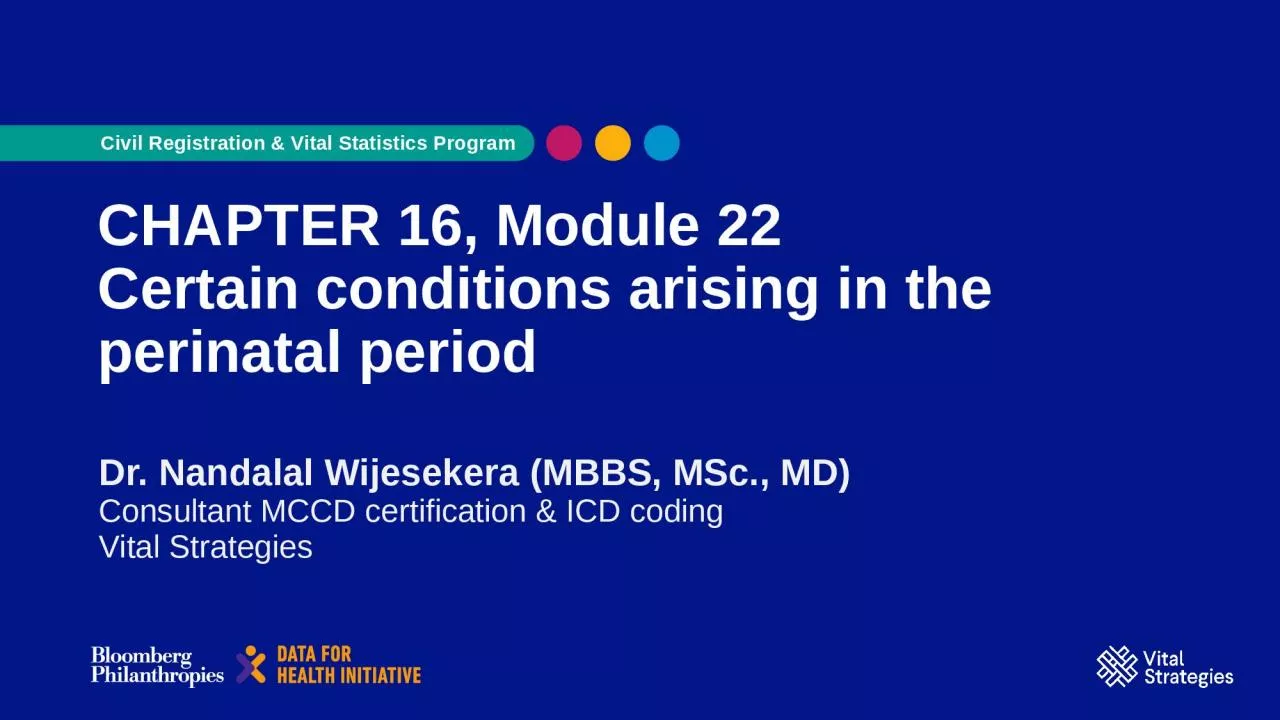

Dr Nandalal Wijesekera MBBS MSc MD Consultant MCCD certification amp ICD coding Vital Strategies Chapter 16 Diseases of the Genitourinary System Chapter 16 of Tabular List Page 206 of your Workbook ID: 1026378
Download Presentation The PPT/PDF document "CHAPTER 16, Module 22 Certain conditions..." is the property of its rightful owner. Permission is granted to download and print the materials on this web site for personal, non-commercial use only, and to display it on your personal computer provided you do not modify the materials and that you retain all copyright notices contained in the materials. By downloading content from our website, you accept the terms of this agreement.
1. CHAPTER 16, Module 22Certain conditions arising in the perinatal periodDr. Nandalal Wijesekera (MBBS, MSc., MD)Consultant MCCD certification & ICD codingVital Strategies
2. Chapter 16Diseases of the Genitourinary SystemChapter 16 of Tabular ListPage 206 of your Workbook
3. Important points for module 22Categories range from P00 to P96Of the 100 available categories 59 have been allocated.There is one inclusion at the beginning of this chapter, and 5 exclusions.Disorders related to length of gestation and foetal growth - birth weight takes priority over gestational age.
4. Live birthLive birth is the complete expulsion or extraction from its mother of a product of conception, irrespective of the duration of pregnancy, which after such separation, breaths or shows any other evidence of life, such as beating of the heart, pulsation of the umbilical cord, or definite movement of voluntary muscles, whether or not the umbilical cord has been cut or the placenta is attached; each product of such a birth is considered live born.
5. Foetal deathFetal death is death prior to the complete expulsion or extraction from its mother of a product of conception, irrespective of the duration of pregnancy, death is indicated by the fact that after such separation the foetus does not breath or shows any other evidence of life, such as beating of the heart, pulsation of the umbilical cord, or definite movement of voluntary muscles.
6. Birth weightThe first weight of the fetus or new born obtained after birth
7. Low birth weightBirth weight less than 2500g (up to, and including 2499g)
8. Very low birth weightBirth weight less than 1500g (up to, and including 1499g)
9. Extremely low birth weightBirth weight less than 1000g (up to, and including 999g)
10. Gestational ageMeasured from the first day of last normal menstrual period Expressed in completed days or completed weeks
11. Pre-termLess than 37 completed weeks (less than 259 days) of gestation
12. TERMFrom 37 completed weeks to less than 42 completed weeks (259 - 293 days) of gestation
13. Post-term42 completed weeks or more ( 294 days or more) of gestation
14. Perinatal periodThe perinatal period commences at 22 completed weeks (154 days) of gestation (the time when birth weight is normally 500g), & ends 7 completed days after birth
15. Neonatal periodThe neonatal period commences at birth & ends 28 completed days after birth
16. Neonatal deathDeaths among live births during the first 28 completed days of life
17. Early neonatal deathDeaths occurring during the first 7 days of life
18. Late neonatal deathDeaths occurring after the 7 day but before 28 completed days of life
19. Important points for module 22P07 gives guidance on the assignment of this code if both birth weight & gestational age are specifiedP10-P15 birth trauma is classified to six categories which are arranged according to the physical effect of the injuryP35-P39 includes only congenital infections & parasitic disease & those infections acquired in utero or which are present at birth
20. Exercise 14 has 5 codes!! A useful hint
21. Answers for module 221. P07.0 2. P95 3. P83.5 4. P92.9 5. P11.5 6. P05.2 7. P96.0 8. P37.0 9. P96.4 10.P61.0
22. Answers for module 22…11. E70.012. P08.2 or P08.1 for new edition13. P04.114. P07.1, P25.1, P22.0, P59.9, P21.015. Q65.316. P22.017. P55.118. P36.919. P11.320. P55.9
23. Thank you!